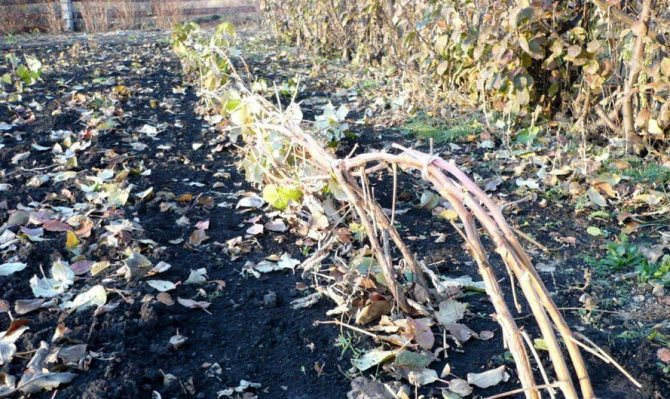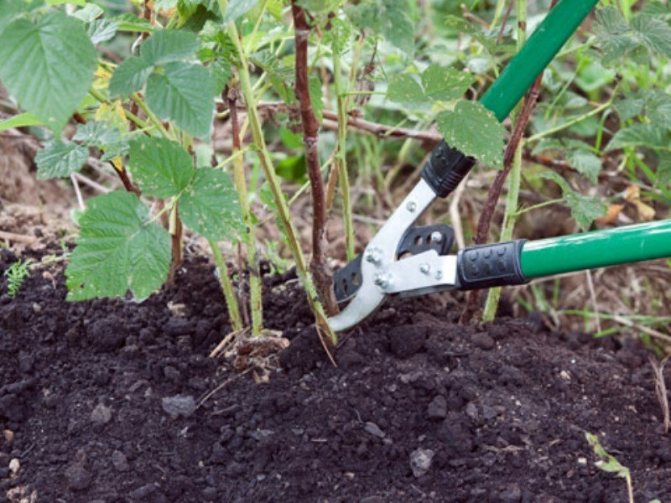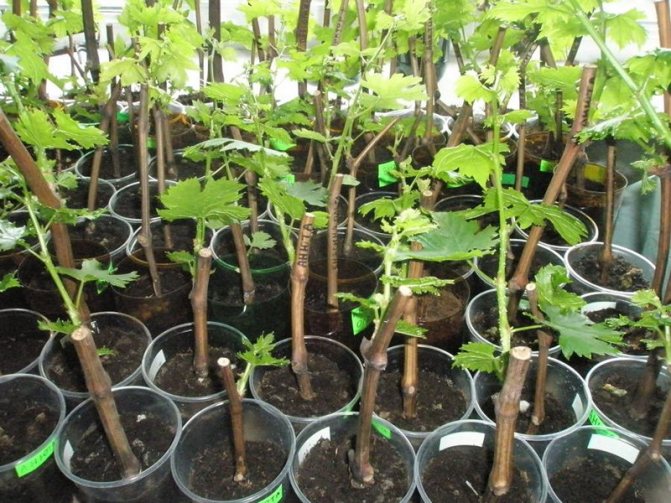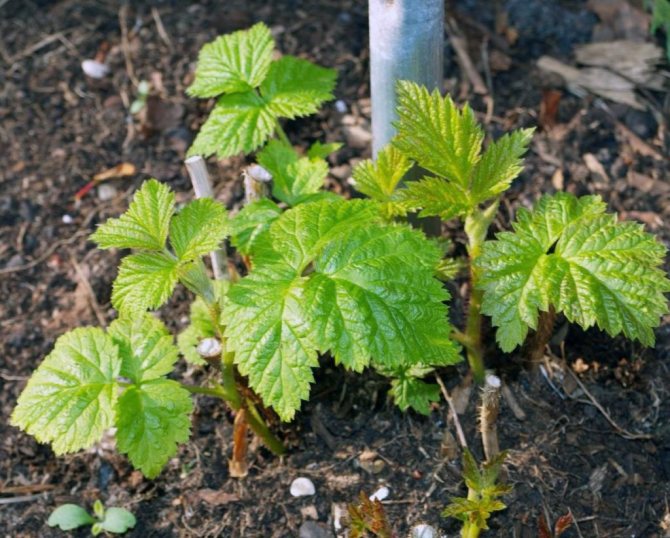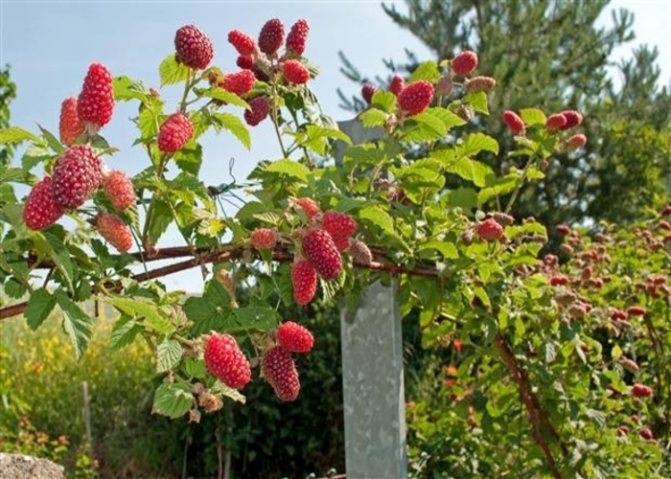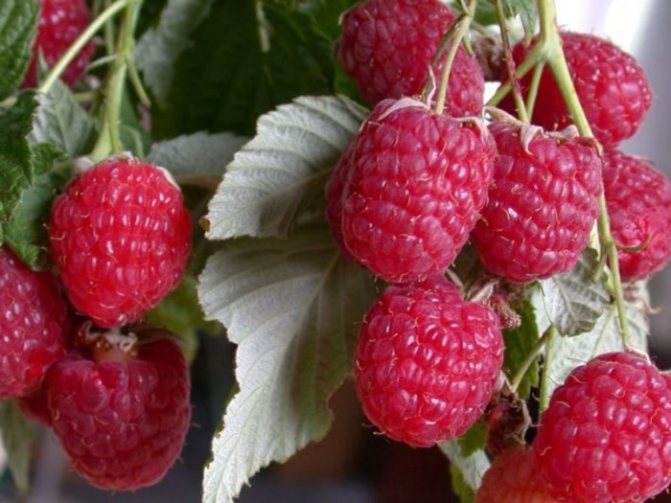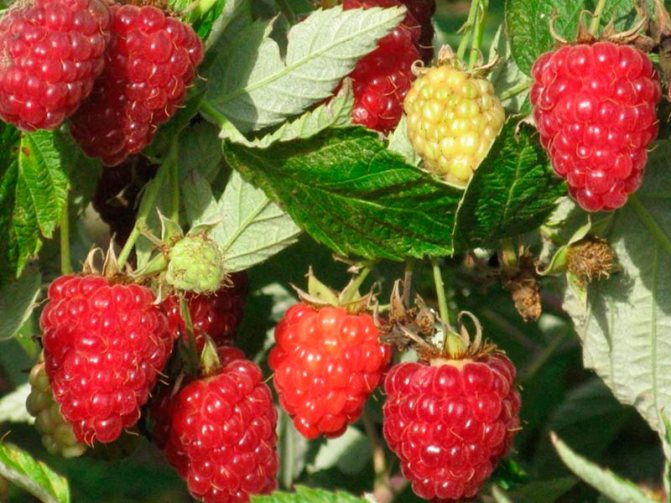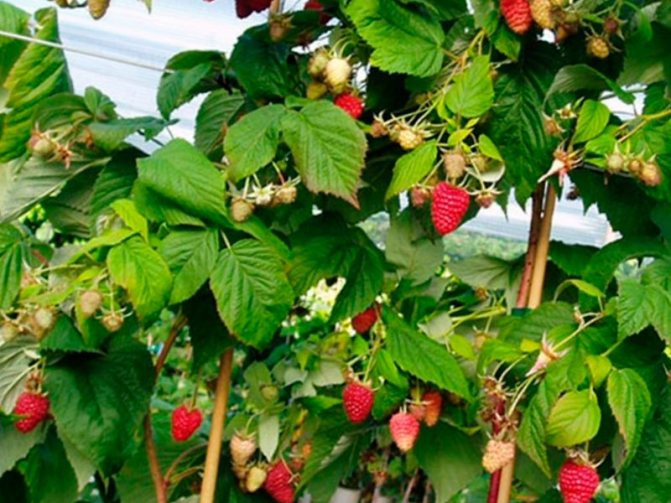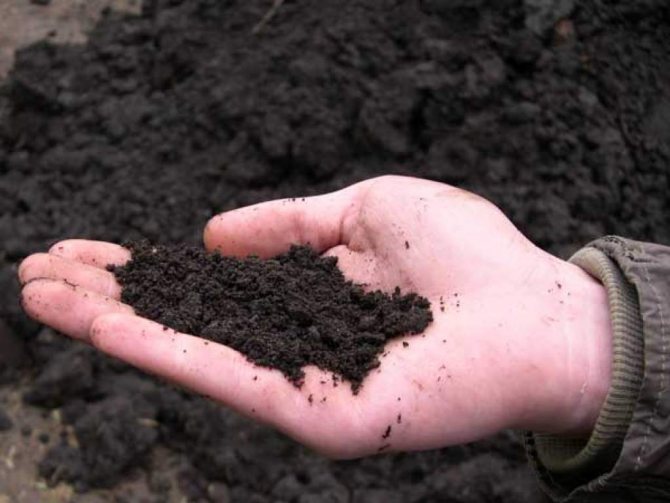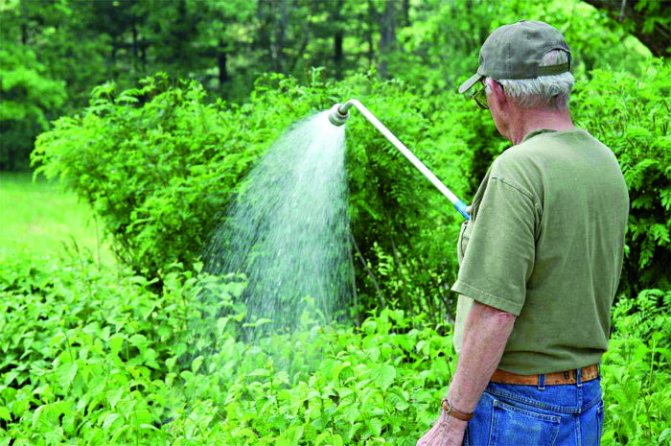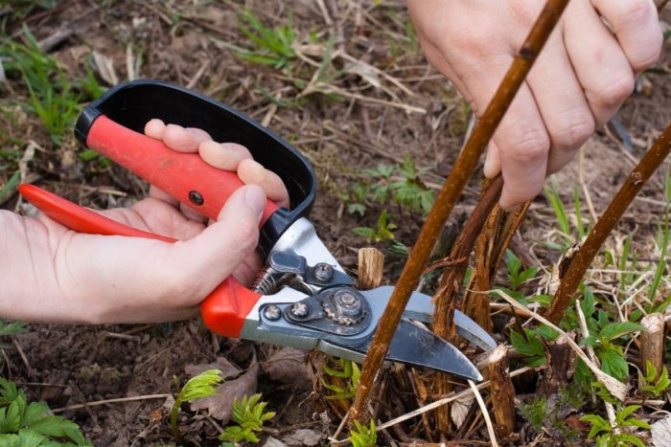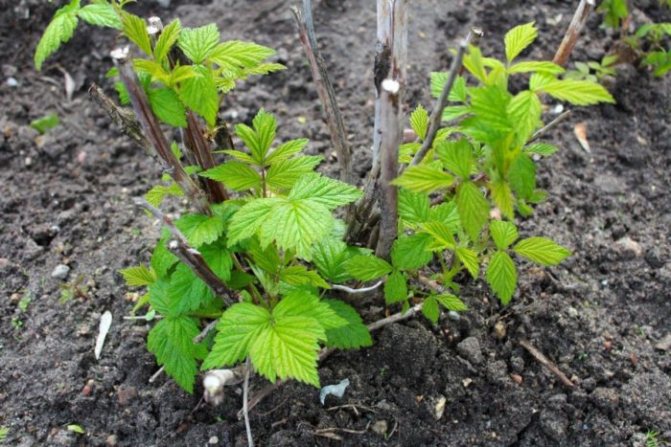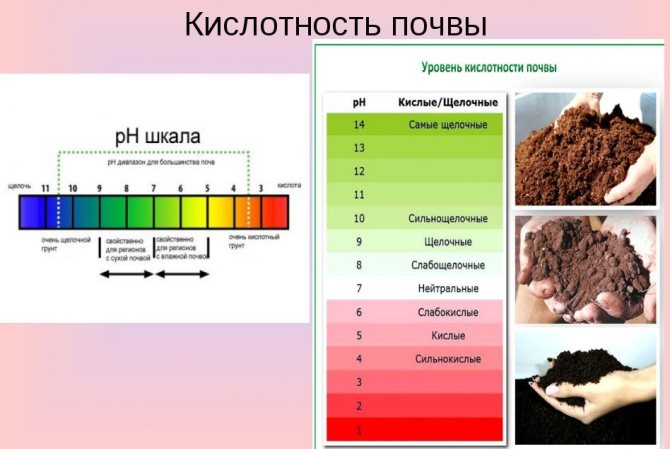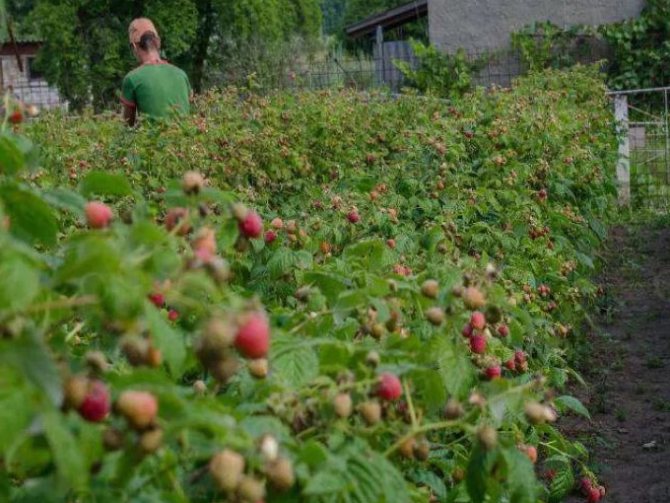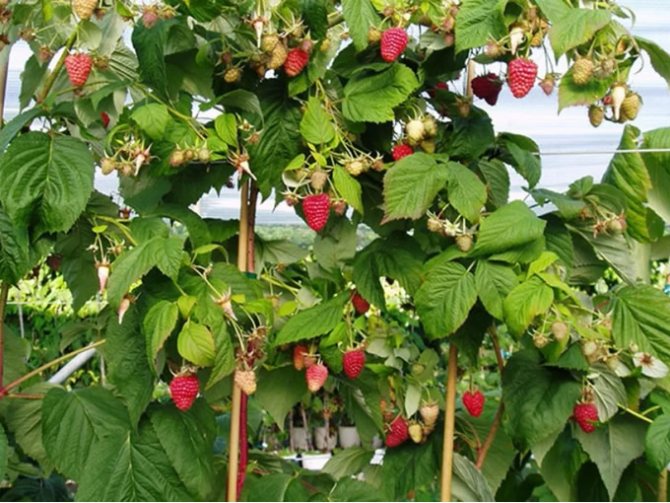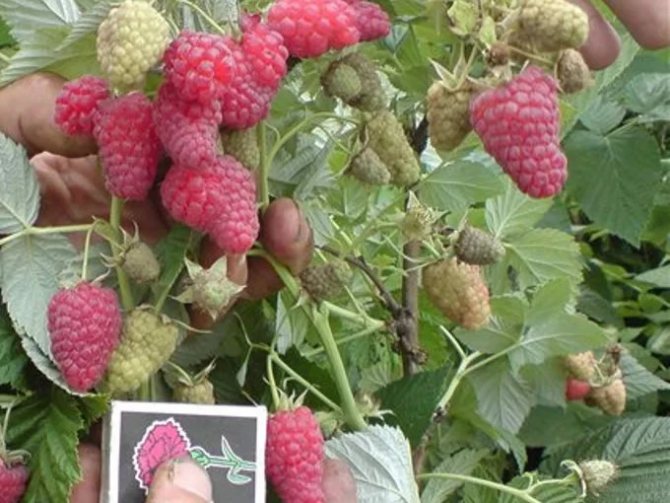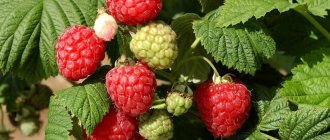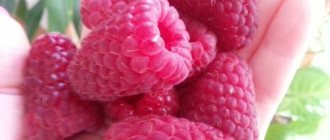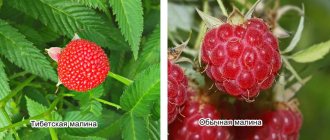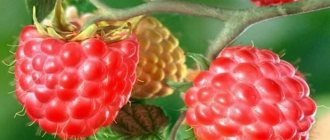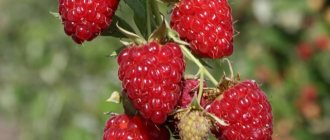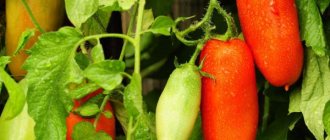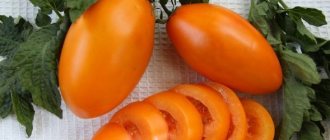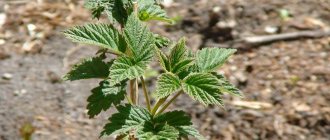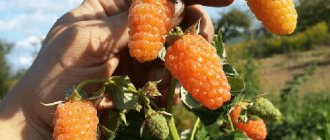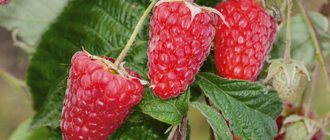Raspberry “Tarusa” is often found in literature or on the net under the name “Raspberry tree”. And indeed, when properly shaped, its bush looks like a young apple tree or pear, especially since the thickness of the stem is almost comparable to that of a rake.

Important! Still, raspberries are a shrub, and they get the look of a tree only when the correct pruning of the bush is done.
Let us note the advantages of the Tarusa raspberry variety, thanks to which an increasing number of gardeners grow it on their plots.
- High productivity with proper pruning.
- Great taste of large berries.
- Good keeping quality of berries and their transportability.
- Powerful root system with a small number of replacement shoots - overgrowths.
- The stems are very strong and do not need support.
- The absence of thorns allows you to harvest without fear.
- High winter hardiness.
- Good disease resistance.
Biological features
Raspberry is a perennial plant that belongs to the pink family. It is a deciduous shrub with a two-year development cycle. The stems are erect, in the first year they are grassy green in color, the next year they grow stiff, and after the end of fruiting they completely die off. The fruit is complex, consists of fused drupes, can have a different color: red of different shades, yellow, orange and even black.
Attention! Raspberries are a good honey plant. It can be pollinated by bees even during light rain due to the special arrangement of the flowers.
Varietal variety
The first cultivated raspberry plants appeared in the 16th century and since then the varietal diversity has been constantly growing. According to the characteristics of fruiting, raspberry varieties are divided into remontant and non-remontant. Not so long ago, varieties with a special structure of shoots, the so-called standard or tree-like ones, were bred. Their shoots are very strong, have a great thickness and look more like a small tree. Sometimes they are called that: crimson tree. Raspberry Tarusa is a worthy representative of raspberry trees.
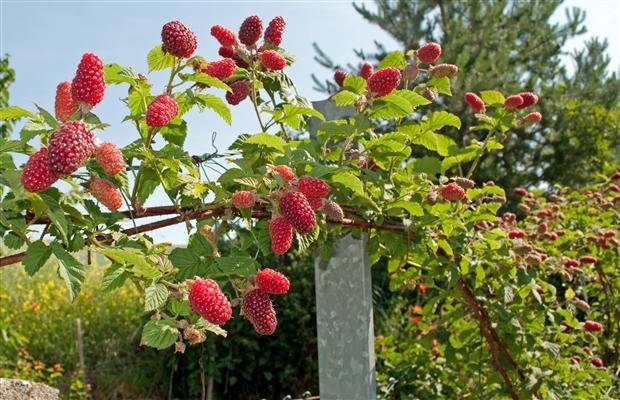

From the history of the appearance of the variety
Tarusa was bred in 1987, and since 1993 it went on sale and began to gain popularity among gardeners. The creators of the variety were employees of the All-Russian Institute of Selection and Technology of Horticulture and Nursery of the Russian Agricultural Academy, led by a famous breeder, Doctor of Biological Sciences, Professor Viktor Kichina.
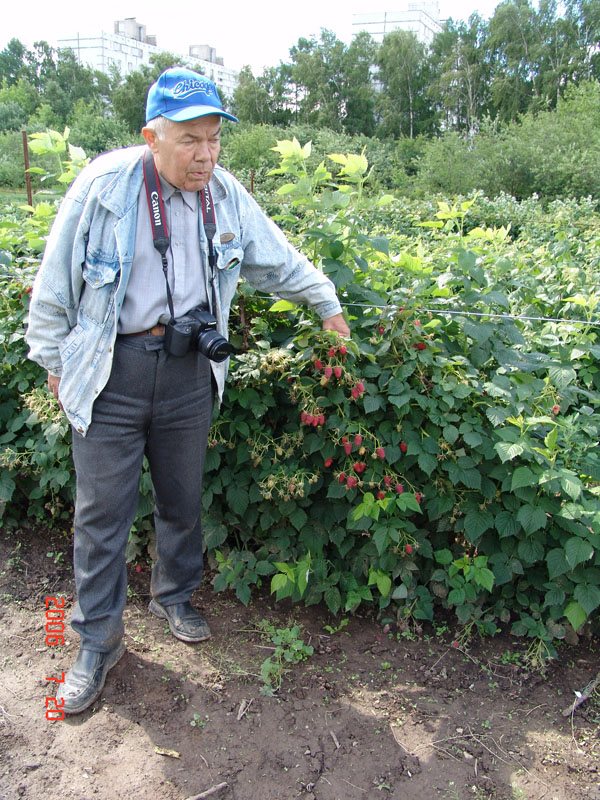

Famous breeder, Doctor of Biological Sciences, Professor Viktor Kichina near raspberries, bred under his leadership
The variety was obtained by crossing the form of the Scottish selection Shtambovy-1 and the domestic variety Stolichnaya.
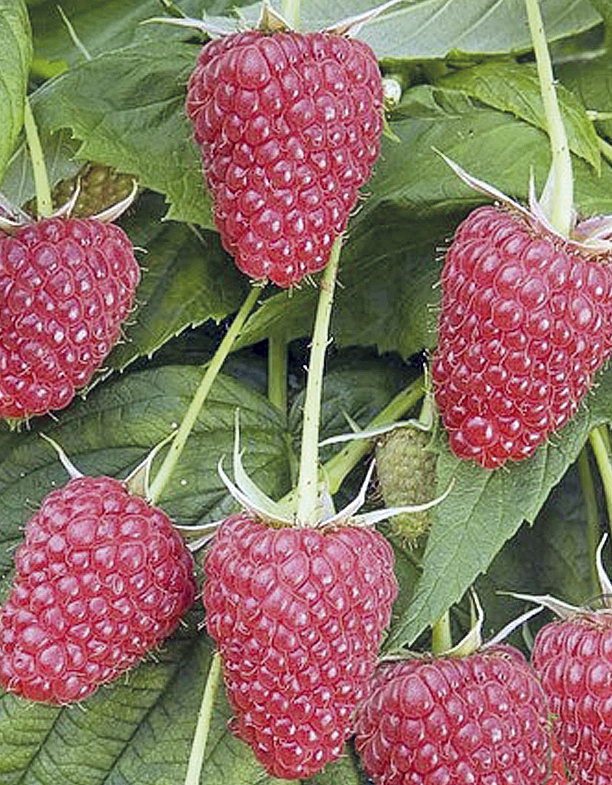

Raspberry Stolichnaya - the progenitor of Tarusa
Tarusa combined the best qualities of parents: large-fruited and productive Scottish hybrid, resistance to diseases and cold raspberries bred in our area.
The name raspberry was named after the ancient Russian city of Tarusa, in the Kaluga region.
Varietal features of Tarusa raspberries
The raspberry variety Tarusa was obtained, tested and introduced into cultivation by a domestic breeder, Professor, Doctor of Biological Sciences Viktor Valerianovich Kichina in 1993.From their parents, large-fruited Scottish hybrids, the Tarusa raspberry took an impressive size of berries and a significant yield. Domestic varieties that participated in the selection process gave Tarusa raspberries winter hardiness, resistance to diseases and pests.
What is it - this crimson Tarusa tree?
The description of the Tarusa raspberry variety should start with the size of the berries: they are much larger than the average size and can weigh up to 15 grams. The length of the berry is also impressive - up to five centimeters!
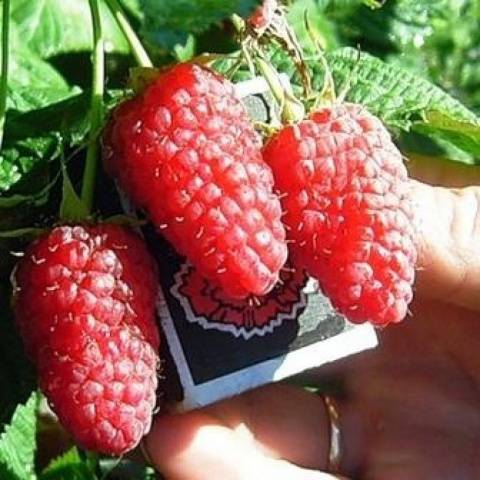

The color is bright, deep red. Tarusa has a pronounced raspberry aroma. A characteristic feature of the Tarusa raspberry is the frequent doubling of the berries, which increases not only its weight, but also the yield as a whole. And he is already very weighty - it reaches four kilograms or more from one bush per season. This is the highest rate among all standard raspberry varieties. The berries hold well on the bush and do not crumble for a long time. Their taste is pleasant, with a slight sourness.
The Tarusa raspberry bush is very decorative, compressed type with powerful shoots reaching a height of one and a half meters. The lower - the standard part of the side shoots does not have, they grow in the middle and upper parts of the bush, forming a kind of crown, like that of a tree. The number of side shoots in Tarusa raspberries, which provide an excellent harvest, can reach ten with a length of up to 50 cm. A distinctive feature of this raspberry variety is the absence of thorns, which not only makes it easier to care for the plant, but also makes harvesting a pleasure. The ability to give replacement shoots in raspberries of the Tarusa variety is low, there is enough for reproduction of shoots, but it will no longer creep over the site.
The frost resistance of the Tarusa raspberry tree is up to - 30 degrees, in regions with a more severe climate, the relatively small height of the bush allows it to be hidden under the snow, gently bending the shoots to the ground.
Attention! The bending of raspberry shoots should be carried out gradually over several stages and before the onset of frost, which makes the shoots fragile.
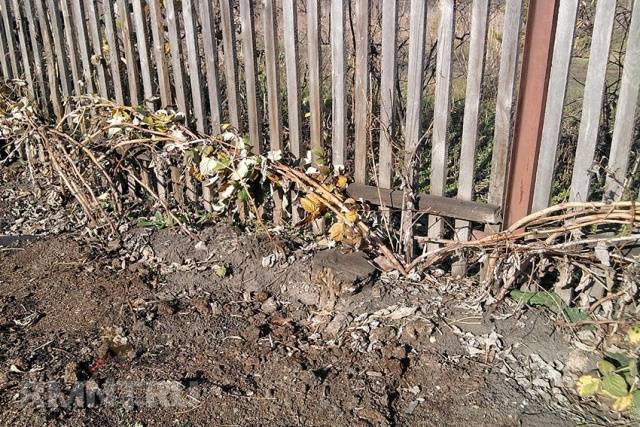

In terms of ripening, the Tarusa raspberry variety is medium late, the fruiting time depends on the zone in which it grows and ranges from early July to late August. The description of the Tarusa standard raspberry variety will be incomplete, if not to say that the dense berry after harvesting is well stored and transported, since it does not give juice for a long time.
Secrets of experienced gardeners
In order for raspberries of the Tarusa variety to give a good result, the following points must be taken into account:
- Be sure to leave landing distance between holes... The raspberry tree should grow freely. Approximate distance 1.5 m;
- Soil acidity should be absent or minimal;
- Try not to plant raspberries in the lowlands... In this case, there will be no chance of accumulation of groundwater, the roots will not rot;
- There will be no good harvest without fertilizing the soil... This variety is very fond of mulching and fertilization;
- For the winter, it is better to bend the stems of the plant to the ground.rather than cover.
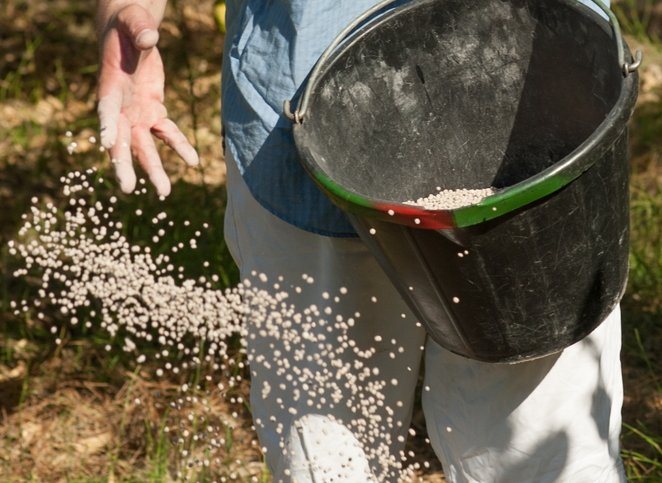

Fertilizers should be used to get a good harvest.
Agrotechnics of the raspberry tree Tarusa
Raspberry is an undemanding plant, but the standard varieties, to which the Tarusa raspberry belongs, have their own characteristics in care.
What does the standard raspberry Tarusa like and what does not like?
The main condition that ensures good growth, health of the Tarusa raspberry and its rich harvest is compliance with the requirements of the variety for soil, water and light conditions, and top dressing.
What kind of soil is needed
Raspberries of the Tarusa variety love to eat. Therefore, the land must be fertile. Loose, loamy and sandy loam soils saturated with organic matter are well suited. On sandy soil, the Tarusa raspberry will be oppressed due to the lack of the necessary moisture, the yield will decrease, the berries will be small. Even frequent watering will not improve the situation.The only way out is to improve the soil by adding a sufficient amount of organic matter and a little clay. Sand must be added to clay soil. An important indicator is the level of acidity. Raspberries do not tolerate soils with a pH less than 5.8. The optimal pH values are from 5.8 to 6.2. If the soil does not meet these requirements and is too acidic, it must be limed in accordance with the norms of the lime composition on the package.
Advice! If you plan to plant raspberries in the spring, the soil is limed in the fall, you cannot do this before planting, since most of the nitrogen contained in the soil is lost during liming.
Moisture requirements
Raspberry Tarusa is not suitable for either a too dry or too wet area. In places where groundwater is high, this shrub will not grow, since the roots easily rot from the increased amount of moisture. The soil should be moist, but without stagnant water. In dry weather, watering is required every ten days, especially when pouring berries.
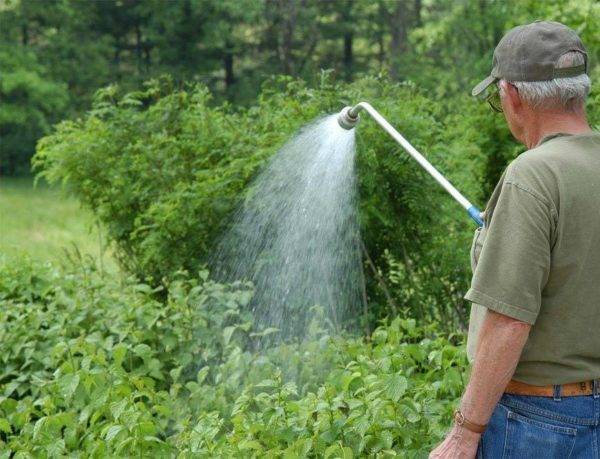

Advice! When watering raspberries, you need to completely moisten the entire layer of soil in which the roots are located. It is at least 25 cm.
Mulching the soil around the plants will help reduce the amount of watering. Any organic matter is suitable for mulch, except for fresh sawdust. The layer of mulching material should not be less than ten centimeters, but preferably more.
The need for lighting
Raspberry Tarusa loves the sun, in extreme cases, partial shade is suitable. In the shade, raspberry shoots stretch out, the harvest drops sharply, the berries become sour. There is a rule - the more sun, the sweeter the berries. When choosing a site for planting, you need to remember that the Tarusa raspberry does not tolerate drafts and gusts of wind.
Top dressing: when and with what
The more productive the crop, the more nutrients it needs to grow. Standard raspberry Tarusa is a variety with high potential yield. Therefore, special attention must be paid to feeding. The need for raspberries of the Tarusa variety in different food elements is not the same.
- Potassium needs are met by applying 300-400 grams per square meter of wood ash. It is enough to scatter it under the bushes once a season in spring and lightly embed it in the soil. This shrub does not like deep loosening, superficial roots are damaged. In addition to potassium, ash contains phosphorus and many trace elements and prevents soil acidification.
- Tarusa stock raspberries need a lot of nitrogen fertilizers. One-time feeding is indispensable here. The best composition - 10 grams of urea and a kilogram of manure are added to 10 liters of water. The mixture is mixed well and the plants are watered at the rate of 1 liter per bush.
The first feeding coincides with the moment of bud break. The second and third feeding is carried out with an interval of fourteen days. Each feeding should be accompanied by subsequent irrigation with clean water. Watering is not carried out only if it is raining heavily.
Advice! Raspberry Tarusa responds well to root feeding with herbal infusion with a predominance of nettle.
There should be more than half of the herbs in a non-metallic container, the rest is water. After a week of infusion, top dressing is carried out at a dilution of one to ten, one liter per bush. During the season, it is enough to carry out 2-3 feeding.
At the stage of raspberry budding, foliar feeding is carried out with complex fertilizer with microelements Ryazanochka or Kemira-Lux at the rate of 1.5 teaspoons per bucket of water. Top dressing is carried out on the growing moon in a fertile sign in cloudy but not rainy weather. The fertilizer solution is sprayed from the sprayer, wetting the leaves well. Before the evening dew, he must soak in them.
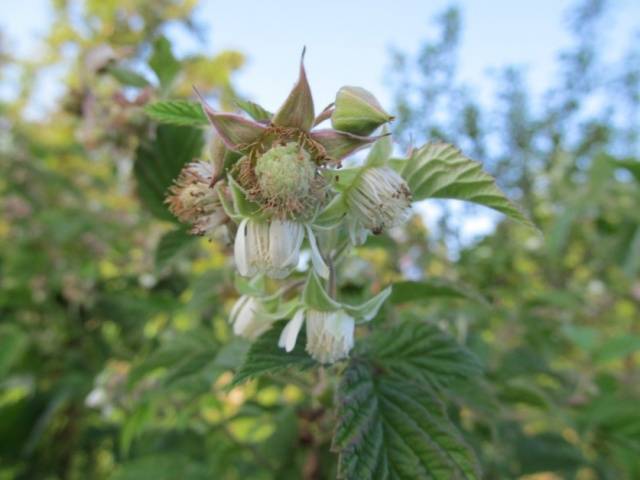

Attention! It is impossible to feed Tarusa stock raspberries with mineral fertilizers with a high nitrogen content in late summer, and even more so in autumn.
Nitrogen promotes the growth of leaf mass and prolongs the growing season. The plant will not have time to prepare for a state of dormancy and will leave weakened in the winter. Potash and phosphorus fertilizers of 30 and 20 grams per square meter, respectively, must be applied.
conclusions
Raspberry Tarusa is quite popular among gardeners. With proper care of the plant, you can harvest a good harvest throughout the summer.
The berries are quite large, juicy, and have a pleasant taste. Similar grade perfectly tolerates transportationwhich plays into the hands of entrepreneurs who do not like to lose their profits. The main thing is to pick the berries correctly. It is better to do this in the morning, in dry weather. But after the rain, harvesting is not worth it, the berries will quickly deteriorate.
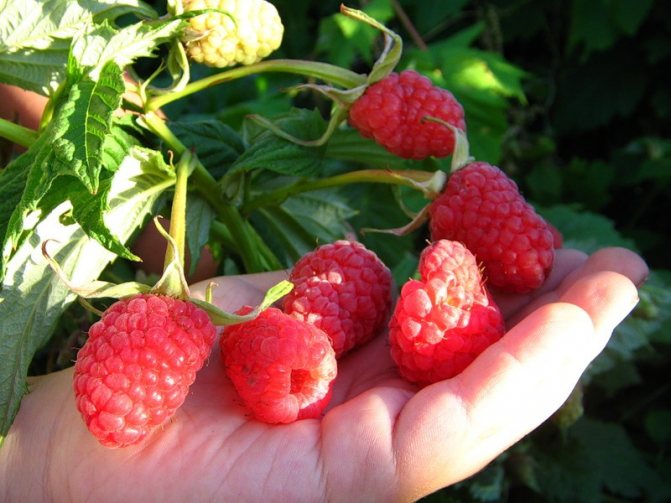

It is advisable to pick raspberries in the morning.
Planting the Tarusa raspberry tree
You can not plant Tarusa standard raspberries after potatoes, tomatoes and other nightshades, and even more so after raspberries, this contributes to the outbreak of diseases and the spread of common pests. The proximity of nightshades and strawberries for raspberries is undesirable for the same reason.
Advice! Raspberries and apple trees get along well with each other.
Fruiting from such a neighborhood improves in both crops, and there are fewer diseases. You need to plant raspberries on the south side of the apple tree and so that it does not shade it too much.
Instructions for planting standard raspberries Tarusa
- The soil must be prepared in advance - for spring planting in the fall, and for autumn planting in the middle of summer.
- The distance between the rows is about two meters, and the bush from the bush should be no closer than one meter, this is required by the growth characteristics of the standard raspberry variety Tarusa.
- If you plan to plant several bushes, then use the pit planting method, if you are going to lay a large plantation, then it is preferable to plant raspberries in trenches.
- So that in the future the area under the Tarusa raspberry was clean of weeds during its preparation, it is necessary to carefully select all the roots, digging up the ground.
- With a pit landing, their diameter and depth are forty centimeters. The depth and width of the trenches are 40 and 60 centimeters, respectively.
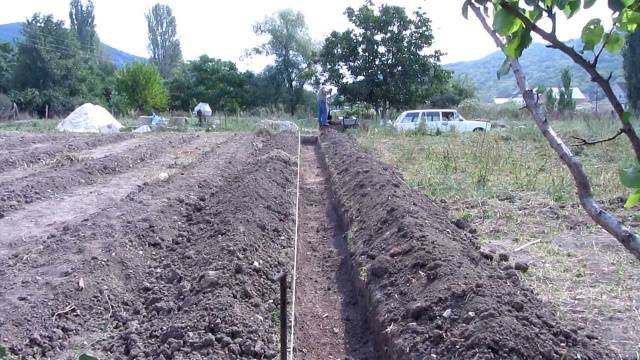

- In the trenches, as in the pits, it is necessary to add humus - one bucket per pit and two buckets per running meter of the trench, ash 0.5 and one glass, respectively, potash fertilizers 15 and 30 grams, respectively, phosphorus 20 and 40 grams.
- Watering raspberries when planting should be very good - up to 5 liters per bush. It is best to plant the plants in mud, then the survival rate will be better.
- Before planting, the root system of the seedlings is kept for two hours in a solution of root formation stimulants: heteroauxin, root.
- When planting, the root collar is deepened by 2-3 centimeters.
- After planting, the Tarusa raspberry shoot is cut to a height of 40 centimeters.
- The soil around the planted plant is mulched to retain moisture.
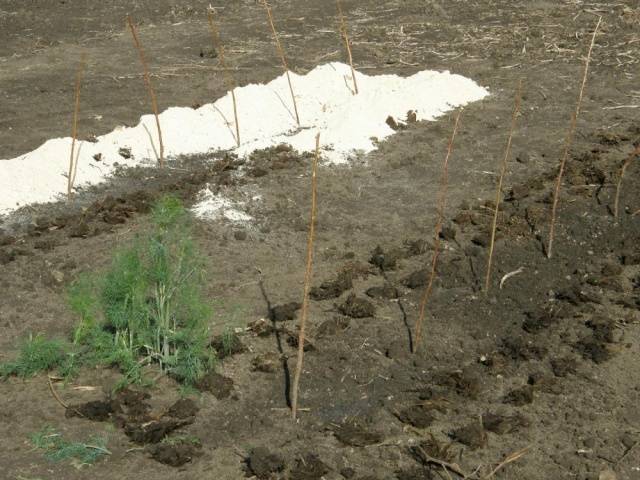

Planting dates can be both autumn and spring. The spring planting is carried out before the buds swell, the autumn planting - a month before the onset of the frosty period. The specific dates depend on the region in which the Tarusa raspberry will grow.
A warning! When planting Tarusa raspberries in autumn, all leaves must be removed from the seedling.
Weak sides
- Prolonged fruiting period, there is no mass ripening in a short time. But this allows you to be with the berry throughout almost the entire summer.
- The taste is mediocre, bland, unsaturated, berries contain little sugar, sometimes dry.
- Often, gnarled, deformed and double fruits are formed.
- Raspberry shoots begin to bend under the weight of the fruit, the head of the bush bends to the ground first. Strong winds can break them. Laterals can also break off under the weight of the pouring berries. Tarusa's tapestry is sometimes not just needed, but extremely necessary.
- The high price of planting material due to the inflated popularity of the variety and the attributed qualities.
In the end, I would like to say a little about the price of planting material and the term "crimson tree" itself.
In the nineties of the last century, the Russian professor V.V. Kichina created standard varieties of raspberries with strong, tough, erect stems. And this played into the hands of the seedlings traders. Using the low awareness of buyers at that time, dishonest sellers named them trees. And for even greater excitement, they were credited with fantastic yield indicators, huge fruit sizes and other similar characteristics.
In 2006, V.V. Kichina proudly remarked: "Tarusa is sometimes called the 'raspberry tree' for its powerfully developed shoots and the bush as a whole." This is from the category of a grandiose scam that has successfully swept across Russia and Ukraine, called "curly strawberries". And as it turned out in practice after the purchase - ordinary remontant varieties with long mustaches and rosettes blooming on them, which, well, did not want to curl in any way. Honestly, even now, in the process of preparing the article and analyzing the market, I came across sites selling seedlings of this raspberry as something super exclusive. We will not name them, but some of them are quite famous. And the hair stood on end at the price of these seedlings! I wanted to call and ask - is everything all right with your head? How can you rip off buyers like that? 1300 rubles for a seedling ??? For what? Probably, the entire life cycle of this plant will be controlled by a specially hired agronomist and his salary is already included in the cost of planting material. A big request to readers - do not overpay hundreds and hundreds of rubles for such varieties. Yes, in principle, for any. They don't even come close. For example, in neighboring Ukraine, the price of Tarusa is 25-30 hryvnia (this is about 70 rubles) for a good seedling. We have led this example to clarify its real cost. Good luck and good harvests to you!
Tarusa raspberry tree care
Raspberry care consists of loosening and weeding at least 6 times per season, watering as needed, fertilizing, pest control: raspberry beetle, raspberry gall midge and raspberry stem fly.
Replacement shoots in Tarusa raspberries need to be normalized, leaving no more than four to six for this variety. The necessary stage is the formation of a bush. To obtain a true raspberry Tarusa tree, double pruning should be used. How to do it correctly is shown in the video:
With proper care and formation of the bush, the Tarusa raspberry tree will delight you with a large harvest of beautiful and tasty berries.
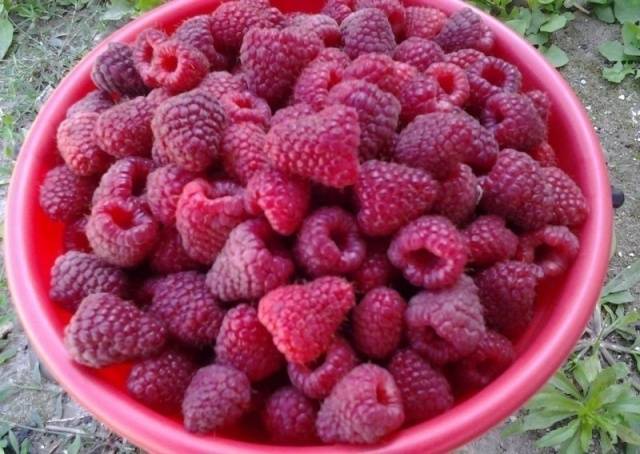

Major diseases and pests
The culture is resistant to parasites and diseases. However, sometimes she suffers from such problems:
- Aphids - Leads to leaf damage. Dealing with parasites is easiest at the initial stage.
- Chlorosis - characterized by yellowing of the foliage and a decrease in yield.
- Raspberry beetle - absorbs the foliage and flowers of the crop.
- Raspberry moth - affects the buds of the culture, which provokes a slowdown in its growth.
- Weevil - affects buds and stalks. As a result, the branches of the culture die off and crumble. To cope with parasites, use Iskra-M.
To protect plants from pest attacks, it is recommended to carry out preventive treatments. In this case, it is worth using special means. With pronounced damage to plants, it is easier to remove them from the site.

